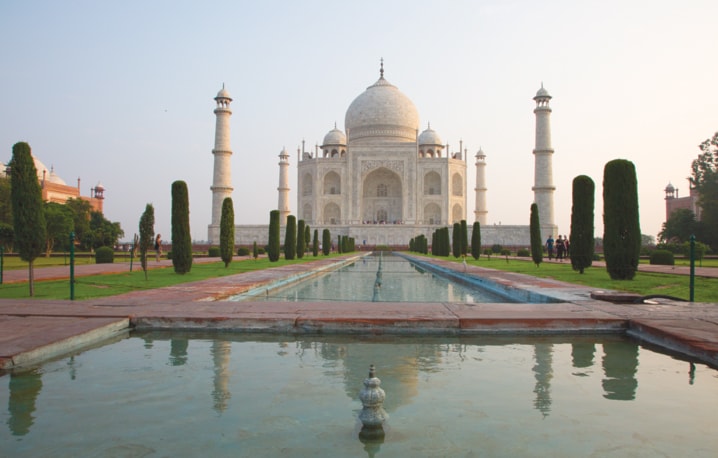No trip to India would be complete without a visit to the Taj Mahal, the monument to love.
So, leaving Delhi behind, we drive by coach to Agra. We see a different side of India — agriculture. Water buffalo wade in rice paddies. Shepherds herd sheep through villages. Manure cakes, a source of fuel, are dried in conical shaped huts.
Brightly painted trucks, loaded with goods, carry passengers atop their loads. Truckers wash themselves right on the street. Women and children wave at us.
When we arrive in Agra, it’s supper time and we check into a hotel. We’ll see the Taj tomorrow.
Our tour guide, Prince, has been to Agra and the Taj Mahal many times. He knows it’s best to get there before sunrise. It will be cooler. We are told that it would be unbearably hot and blindingly bright later on in the day.
We arrive at the massive main gate that will lead us to the mausoleum. The Taj Mahal, or ‘crown of palaces,’ is not a building in isolation but part of a complex set of structures. Construction began in 1632, and for 20 years, 20,000 men worked on this elegant mausoleum.
We walk through a security scanner and emerge on the other side. There is the Taj Mahal ahead of us, but almost half a mile away.
The sun has not risen yet and the light is ethereal, making us wonder if this is all a dream. The Taj looks like a mirage, shimmering beyond a long narrow garden pool. Then the click of cameras quickly bring us back to reality. We take a group photo and begin to explore the gardens and mausoleum at our own pace.
There’s almost a holy hush as each of us begins the walk towards the Taj Mahal. Nearing the solid white marble domed mausoleum, we are told to put protective socks over our footwear. The interior marble floors need to be protected from the millions of feet that walk here every year.
Shah Jahan was grief stricken when his third wife, Mumtaz Mahal, died giving birth to their 14th child. In her memory, Shah Jahan built this stunning mausoleum. He inlaid it with semi-precious stones and intricate carvings. In the very centre of the symmetrical building sits the tomb of his beloved wife. Next to her resting place is the Shah’s own sarcophagus. There is nothing else in the building. Arch shaped openings from every side of the building lead to the central tombs. It is a memorial — a memorial to love.
The tragedy of this love story does not end there. Many years later, the emperor’s third son, Aurangzeb, seized power and put his father under house arrest. Where? In nearby Agra Fort. From a tower window of the fort, Shah Jahan is able to see the Taj Mahal. He will never again walk in those gardens or reminisce at the mausoleum. His own son has sealed his fate.
The third city of India’s Golden Triangle is Jaipur. It’s known for its well-planned streets and neighbourhoods. Excellent craftsmanship in block printed fabrics, gems and Jaipur rugs can be seen in the many shops lining the main thoroughfares. Jaipur is called the Pink City, as the ancient walls, gates and many of the buildings are painted a deep oleander pink.
Situated on a forested hill just outside the city is Amber Fort. The fort was built in 1599 by Raja Man Singh I. We take a jeep ride, as the road is rough, and stop at Lake Maota. A snake charmer is playing pipe music and a cobra slowly emerges from a basket at the charmer’s feet. Time for a photo and then it’s back to the jeep. Soon we arrive at the base of a rocky hill. At the top of the hill sits the Amber Palace, a royal residence for the rajas of Jaipur.
Elephants and their drivers, called mahouts, are lining up next to a mounting platform. We’re going to ride an elephant to the Amber Palace! Now, this is real India!
Among the shuffling elephants, men are milling about, trying to sell T-shirts, umbrellas and souvenir photos. The sun is already hot so I reach for a gaudy umbrella and Vern gives the happy hawker six rupees. Then it’s our turn to climb from the mounting platform on to our elephant.
We get seated on a square-railed bench that sways with every movement of the enormous animal. Our mahout, a handsome grey haired man, guides the animal up a narrow walled passage.
Intense heat is radiating off the rocky hillside and the stone passage way. Our colourful umbrella provides some relief from the sun.
We hang onto the thin metal rails and each other and sway back and forth to the lumbering rhythm of our elephant.
Lake Maota and the gardens get smaller as we keep ambling up the hill.
Through the Sun Gate we enter Jaleb Chowk, a large courtyard. Like soldiers of old returning victorious from war, our group parades around the courtyard. Our trophies are not the bounties of war, but umbrellas, cameras, backpacks and water bottles.
But, hey, we’ve just ridden an elephant! This is the India we came for and we’re loving it!
Mirjam Rand is a local freelance writer and photographer.
